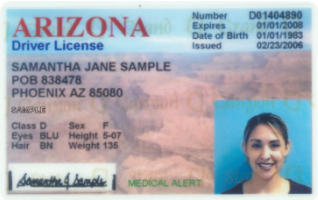The Evolution of Arizona’s Driver License
The Evolution of Arizona’s Driver License


Have you ever wondered what past Arizona driver licenses looked like? You may even have a few iterations of them yourself. Today, we’re taking a look at how the design of Arizona’s driver licenses have evolved throughout the years.
In the 1920s, driver licenses came in the form of small copper key tags that had “Operator’s License” and “State of Arizona” on one side with the driver’s license number as the only identifying information listed.
On the other side, it said “IF FOUND RETURN TO SECRETARY OF STATE JAMES H. KERBY.” That’s because most services that are now handled by the ADOT Motor Vehicle Division fell under the Arizona Secretary of State before the State Highway Department was established in 1927.
That year, 1927, was also when the first law that required drivers to be licensed in Arizona was enacted, but Arizona didn’t require driver license examinations until 1951, making it one of the last states to do so, according to the U.S. Department of Transportation.
The earliest image of an Arizona driver license card we could find is this one belonging to Joe B. Ortega from 1931, courtesy of the Tempe History Museum’s collection.
Records between then and the 1970s are sparse, but we do know that photo driver license and ID cards in Arizona date back to at least 1970, based on this picture we found in our archives of the cards being processed:

That same year, the MVD introduced a new driver license that was “virtually impossible to alter or destroy,” according to the 1971 annual report from the Arizona State Highway Commission.
The earliest up-close image of an ID card we could find in our archives is the photo at the top of this blog, featuring ADOT MVD Driver License Group Manager Michael Groom and Judy Lazzeri displaying a new ID card for Arizonans without driver licenses in 1975.
At the time, the information on Arizona driver licenses was hand-written by the licensee and expired on their birthday after three years. That was extended to four years in 1983.
Although we don’t have official pictures from the era, we do know what Arizona driver licenses looked like back then thanks to photos we found online. Here are mockups we created – we didn’t want to share images of real licenses that included personal information of real people – to show what the licenses looked like in the 1980s:

Arizona began issuing computer-printed licenses in 1988, according to an audit of the MVD’s driver licensing programs. The cards featured a new design with a banner at the top that said Arizona with a cactus in place of the ‘i,’ the state seal in the background and a tamper-proof plastic lamination:

At the time, the MVD was required by state law to process all photo IDs at one location – this is called “central issuance.” That meant all driver licenses and ID cards in Arizona were processed at a central location and then mailed to the licensee. Most states had already adopted the practice of issuing licenses over-the-counter by the late 1980s.
The next decade saw several changes, each one adding new security features that reflected rapid advances in technology.
The design changed slightly in the early 1990s before Arizona adopted a whole new design in 1993. It included a simplified layout with a small banner featuring a picture of a sunset, similar to the image on Arizona’s standard license plates today.

 These licenses featured a holographic film overlay to prevent fraud, were available over-the-counter thanks to digital photo technology and were the first Arizona IDs to be valid until the driver’s 60th birthday, according to an Arizona driver license manual from 1997. The age was extended again to the driver’s 65th birthday in 1999, following legislative action.
These licenses featured a holographic film overlay to prevent fraud, were available over-the-counter thanks to digital photo technology and were the first Arizona IDs to be valid until the driver’s 60th birthday, according to an Arizona driver license manual from 1997. The age was extended again to the driver’s 65th birthday in 1999, following legislative action.
This design did not feature a place to indicate whether the driver was an organ donor, but licensees were given an organ donor card with information and a sticker they could place on the back of their license if they wished to be an organ donor, according to the manual.
The Arizona driver license design changed again in 2001 to a background with a picture of the Grand Canyon and additional security features to reduce fraud, including optically variable ink, which appears to be different colors based on the angle it’s viewed from.

This design also did not include an organ donor designation, but drivers could pick up an organ donor sticker at the MVD to add to their license if they wished to be an organ donor, according to a driver license manual from 2003.
The design didn’t change again until 2014, when even more enhanced security features were added to protect personal information and prevent identity theft, including an intricate background design featuring Rocky the Ringtail and a tactile date of birth.

It also included a “ghost portrait” of the driver's photo and Optically Variable Devices, which display iridescent overlay images of the state seal, a cactus and more that are only visible when you view the license from certain angles.
The release of the new design also marked the return of organ donor designation on the card, as well as “central issuance” as an added security measure to prevent identity theft.
The latest driver license design, released in early 2023, features even more images of Arizona and even more security features. These include a solid structure made of 100% polycarbonate material fused together and black-and-white driver photos that are laser engraved, both of which are extremely difficult to alter.

